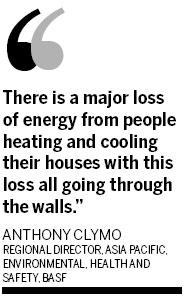News
Proper insulation a way to save energy
By Andrew Moody (China Daily)
Updated: 2010-05-10 11:38
 |
Large Medium Small |
BEIJING: A leading executive from German chemical giant BASF said lack of information about technological advances was a barrier to more progress being made in preventing environmental damage.
Anthony Clymo, regional director, Asia Pacific, Environmental, Health and Safety, said many in the building industry either cut corners or were unaware of the latest insulation products.
"There would be a tremendous reduction in CO2 emissions and there would be a major improvement in the environment," he said.
He said installing proper insulation in residential homes was perhaps one of the most important steps that could be taken to save the world from climate change.

"There is a major loss of energy from people heating and cooling their houses with this loss all going through the walls," he said.
"Insulation material has a positive carbon balance of 250. It takes one carbon to produce enough insulation to save 250 carbons."
He said those building new houses would not fit the latest insulation materials unless they were forced to by regulations.
"No one is going to spend money unless it is required they fit the latest materials. If you can build a very cheap house and get away with it then that is what you will do. There needs to be a great deal more education."
There were major business opportunities for companies that developed technologies. BASF has 12 research and development facilities in the Asia Pacific, including four in China, which have a focus on developing new products to help the environment, Clymo said.
The company's manufacturing facility in Shanghai that produced catalytic converters had made a major contribution to the environment, he said.
Over the past 10 years, the 10 million catalysts it has produced have removed more than 18 million tons of pollutants from the atmosphere.
"We are now looking at future manufacturing facilities elsewhere in China aimed at producing catalysts for the two wheeler vehicle segment," he said.
He said also there was much to do in the way companies organized their production.
The company's joint venture chemical plant with YPC Co of Sinopec in Nanjing, Jiangsu province, generated 65 percent of its own energy and took only 35 percent from the grid. It is based on the Verbund model the company has pioneered in Germany.



